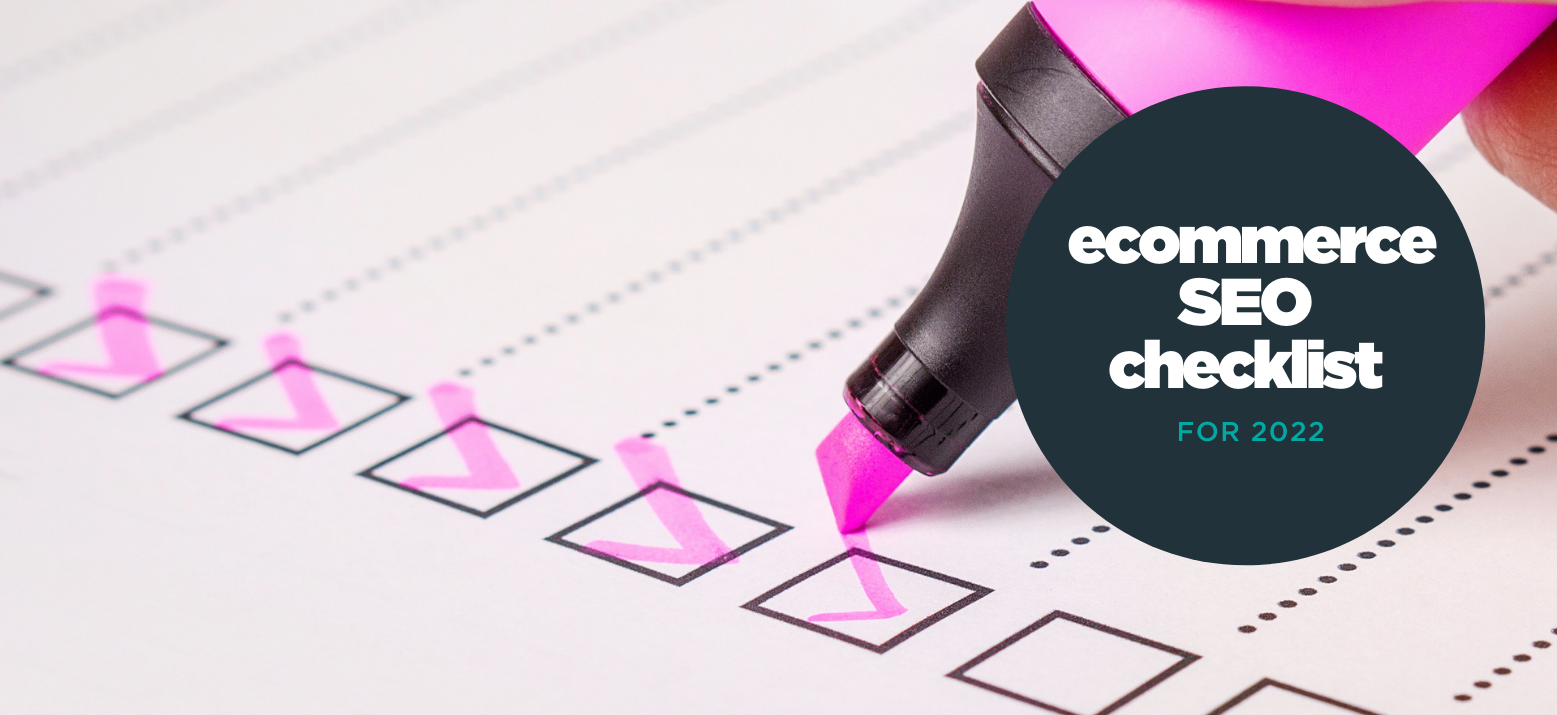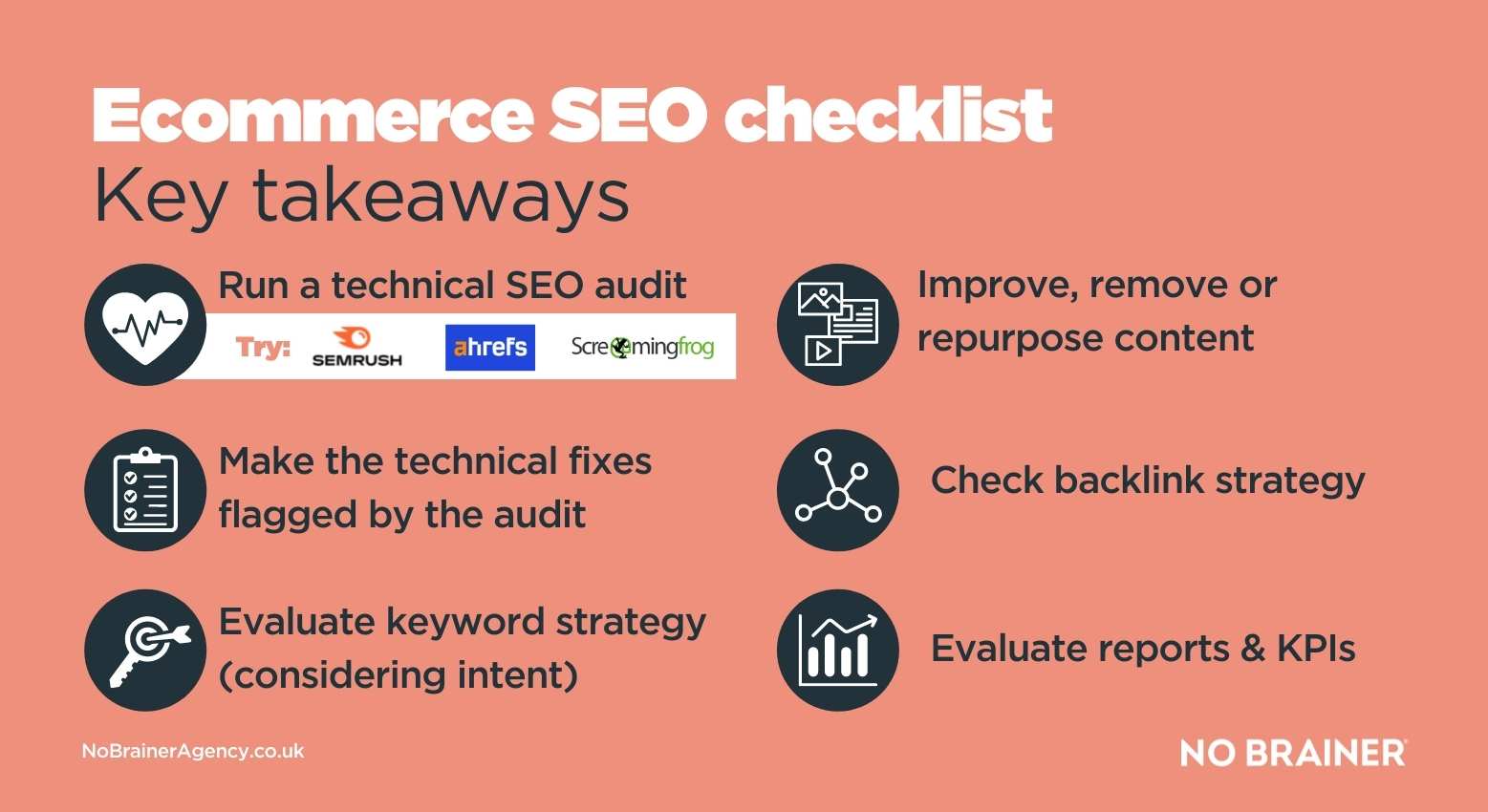Whatever stage or phase that your ecommerce SEO strategy is in, there is always value in taking stock of where things are up to, checking that the basics are still in place and being as effective as they can be, along with ensuring that your plan for the months ahead is solid and the right measurements are in place to keep you on track.
An effective ecommerce SEO strategy will drive highly relevant organic traffic with a great chance of converting into increased sales and revenue for your business, as well as catering for your audience at every stage of the buyer journey.
We’ve compiled this checklist to help ensure that you can start the coming year with the right foundations and set yourself up for SEO success in 2022.
Run a technical SEO audit
A starting point for any new SEO strategy as well as being good practice to do regularly for any ecommerce site, checking your website is fully crawlable, indexable, has an appropriate page speed, has the right schema markup in place e.g. rich snippets on product pages, and is easily navigable by users as well as search engines is an essential on which everything else can be built.
With Google’s mobile-first approach now, it’s vital to make sure that your technical SEO approach also runs along these lines, even if your site has a high proportion of desktop users at present. Any on-page SEO work you do will be limited in its impact if the basics like this are not in place and working as they should.
There are several different tools that you can use to help automate as much of this audit as possible and cut down on the manual work involved, and most SEO experts will use a combination of them to get the most useful data and insights possible, as no one tool or solution is able to do everything. Many of these tools can also help with other areas of your ecommerce SEO strategy though, as well as the technical audit, so this is worth bearing in mind before committing to a subscription.
Some of the most popular SEO tools include:
- SEMrush (some elements are free and some require a subscription)
- Ahrefs (some elements are free and some require a subscription)
- Moz Pro (30 day free trial with ongoing subscription available)
- Screaming Frog (free version can crawl up to 500 pages, so is ideal for small sites – paid version unlimited site size)
- Google Search Console (free)
- Sitebulb (free trial with ongoing subscription available)
- DeepCrawl (subscription)
- Copyscape (works on a credits PAYG basis)
- Google structured data testing tools (free)
- PageSpeed Insights (free)
Set aside time to make all of the required technical fixes
Running an SEO audit is a great way to gather data on the status of your website, but it’s just information unless it’s analysed effectively, and real actions come out of the process.
It’s important to prioritise the SEO work on your website.
Fixes that can make a difference include:
- 404 errors
- Navigation – ensuring your users (and search engines) can better crawl your website, all tied to your keyword research
- Broken URLs/links, redirects and redirect chains
- Missing schema, for example, on product and FAQ pages
- Missing or duplicate page titles and descriptions
- Page speed issues
- Orphaned pages
- Duplicate content (and missing canonical tags)
- And many more!
The SEO audit gives you a great starting point to make sure your website is technically as spot-on as possible from a SEO point of view and gives the ideal platform for the rest of the checklist and your strategy going forward.
Evaluate your keyword strategy
Keywords and their relevance, along with average search volumes, can change over time, so it’s important to evaluate what you’re focusing on, what you’re currently ranking for and look for new opportunities at least a couple of times a year.
Incorporate keywords with intent
![What is search intent for SEO [infographic]](https://www.nobraineragency.com/wp-content/uploads/2023/10/what-is-search-intent-seo.jpg)
Take a look through your keywords and map them to different types of intent – take a look at our handy infographic that explains more about intent, to help you categorise and drill-down into long-tail keywords.
By mapping intent keywords to specific pages on your site and focusing on helping them rank for these terms, you can help pre-qualify the traffic that lands and boost transaction rates.
Check for keyword cannibalisation
If you have different pages on your website competing for the same organic keywords, you may find that the ‘wrong’ pages are shown in search results, or no pages at all, if the search engines are confused about which result is most relevant for searchers. Taking steps to rectify this can have a positive impact on both pages and the terms they rank for when done properly.
Take a look at our guide to ecommerce keyword research here.
Look for underperforming pages to improve or repurpose
Reviewing the performance of content and website pages is another thing that needs to be carried out on a regular basis. It’s not just about the number of sales generated directly, but also the role of that page in the wider journey. Comparing pages of the same type with varying performance can help to highlight reasons why one does better than another in terms of driving traffic that converts or stays on the site for a while.
Repurposing existing content that isn’t reaching its full potential can also be a good avenue to explore. That might mean simply updating info that is out of date, or it could mean taking current content and turning it into something that better engages your audience e.g. turning text into a video, infographics, or another kind of visual content.
Ensure you have a backlink strategy in place
While it is just one ranking factor amongst many, relevant and authoritative links point to your website from other sites is important and is often neglected because it’s hard to do successfully. Ensuring that you have activity in your SEO strategy designed to attract and earn links is essential. You can get some ecommerce link building tips here.
Evaluate your reports and KPIs
Business goals and priorities can evolve over time, but the way that success is measured doesn’t always keep up with this. That’s why it’s important to evaluate what you are measuring and why every so often, to make sure that the reporting you’re doing is actually what stakeholders need to know and is aligned with your current business objectives. Are you using the right metrics and KPIs to prove the value and benefit of SEO to the wider business?
Another side to this is by checking that the attribution model you’re using currently gives the most accurate information in relation to the full channel marketing mix and your SEO efforts. There is no simple answer or perfect model when it comes to attribution, but questioning whether the default settings are the best option at least starts the conversation about how budget and resource is split out and whether that is giving the best possible ROI.
By using this checklist to give your ecommerce website an SEO health check, you can ensure that you’re stacking the deck in favour of success for the year ahead.
If you want to talk your SEO strategy over with our team, or if you’re looking for help with auditing your ecommerce website, we’d love to hear from you.








